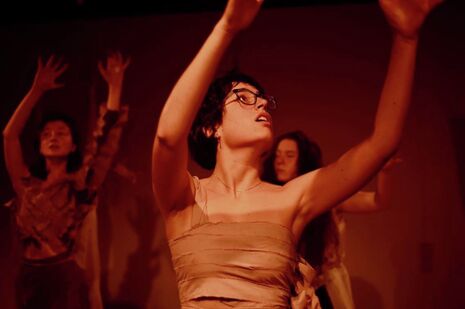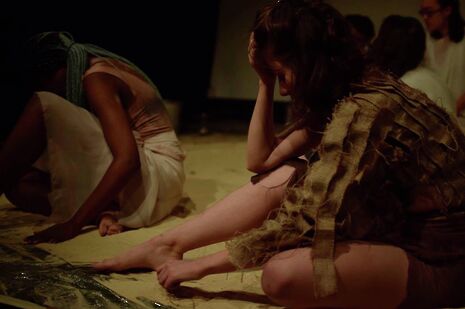Review: e x i l e
The risks of this bold new production most certainly pay off, writes Mimi Robson
Right at the start of e x i l e, the newest student-written production to hit Corpus Playroom, Abhita (Ruby Kwong) remarks: “I honestly give up understanding”. To this, Medea (Niamh Curran) replies: “I did, a long time ago, feel free to join.” As an audience member, this felt like a useful mantra for addressing the deliberate and intelligently executed disorientation that runs through a play rooted in and yet divorced from reality.

I arrived at the Corpus Playroom to find sand on the stage, several buckets hanging from the ceiling, the walls papered over and scrawled on, and members of the cast sat down along the edges of the theatre. For those familiar with Corpus Playroom shows, this sounds much like the ambitious and experimental set we have become worryingly desensitised to. What distinguished this arrangement was how effective it was in the play, and the profound effect that conceptions of space had in this show.
One of the characters asks: “Where is here? We can be anywhere…” This impression of disorientation, both in time and place, was compelling and thought-provoking throughout. The set toyed with the emptiness of a vast wasteland, but combined this with the confinement of the Playroom. The audience are trapped, but in emptiness, nowhere: “nowhere, but it is also everywhere.”
Each character in the six-woman cast felt distinctive and carefully developed; they reacted and interacted well, creating powerful emotional effects. Some of the most engaging scenes were the climatic moments in which all the characters reacted together, but each in a different way, such as the contrast between the silence of Samasti (Claire Takami-Siljedahl) and the speech of the other characters. Their use of choreographed physical theatre was also strong.

My favourite scene of the performance saw the words that Elaheh (Emily Collinson) had written on the walls being dramatically torn away by the censorship of other women. What followed was a well-arranged and artistic shift into choreographed moves, which was a moving reflection on the attempts of women to re-write themselves out of blame. Another great scene was when Agave (Lola Olufemi) tried to extract solidarity from Medea.
What shone in these scenes was the quality of the writing (the excellent work of Faye Guy and Rute Costa), as well as the consideration that had gone into enacting the interplay of the characters. The character of Antoinette (Beatriz Santos) also carried off a number of very moving speeches and scenes: her strong performance deserves special mention.
A huge commendation has to be given for the use of sound and lighting in the play. The ability to intensify and extend the emotional climaxes of scenes through shifts in lighting and ambient music was a well-crafted addition to the piece, and often had a truly beautiful effect.

One slight criticism is that it felt as though some of the scenes went on for too long, losing some of their initial value, and getting swept a bit too far into the characters’ desire for water, which, although integral to the plot, was not as integral to the audience’s enjoyment of the drama.
That being said, e x i l e is a bold choice for a play; it scarcely relies on comedy, it requires a lot of effort to ensure that the centrality of the dialogue in the production does not result in the performance feeling ‘static’, and it attempts to engage its audience in a range of feminist issues. Yet, overall, these risks most certainly paid off.
The play has a huge amount to offer to an audience that reciprocates the immense effort that has gone into the script, as well as its enactment, with a corresponding willingness to think about some of the issues it addresses
 News / Police to stop searching for stolen Fitzwilliam jade17 April 2024
News / Police to stop searching for stolen Fitzwilliam jade17 April 2024 Interviews / ‘It fills you with a sense of awe’: the year abroad experience17 April 2024
Interviews / ‘It fills you with a sense of awe’: the year abroad experience17 April 2024 News / Night Climbers call for Cambridge to cut ties with Israel in new stunt15 April 2024
News / Night Climbers call for Cambridge to cut ties with Israel in new stunt15 April 2024 Sport / Kabaddi: the ancient sport which has finally arrived in Cambridge17 April 2024
Sport / Kabaddi: the ancient sport which has finally arrived in Cambridge17 April 2024 Features / Cambridge’s first Foundation Year students: where are they now?7 April 2024
Features / Cambridge’s first Foundation Year students: where are they now?7 April 2024





